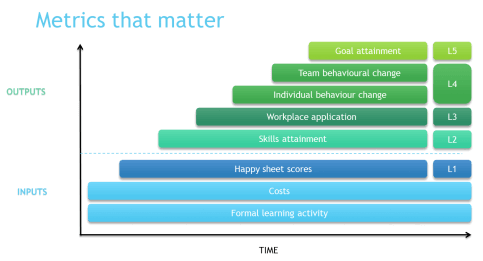Measuring the learning metrics that matter
There was a time when the Learning & Development department was only accountable for the number of people that were put through training and the cost, in other words, basic effectiveness and efficiency.
Things have changed: Learning and development have evolved. Learning professionals now work towards the L&D department becoming recognised for what it is: a business-critical change agent, this means there needs to be a shift in the way that L&D are measured.
No longer can we evaluate the inputs, the number of courses run, attendance, “Happy sheet” scores etc. We have to start looking at the output or outcomes. This is where the challenge begins. What are the outcomes?
Let’s take this back to basics. Quoting Stephen Covey, “Start with the end in mind”, when initiating a programme one of the primary drivers is always “What are the business goals”. If you don’t know what you want how can you change things, how can you evaluate the impact?
So what outcomes could you measure? There is no one size fits all solution to this question, it will depend entirely on the type and purpose of the learning and whether it is formal or informal (on the job) learning. However, the 5 metrics that we would suggest as a reasonable core are:
- Skills attainment: Measure the learner’s level of knowledge or skill pre-learning and again post learning. Have the learner’s knowledge and skill to perform a task improved?
- Workplace application: Is there evidence of the learner applying the newly learned skill or knowledge in the workplace.
- Individual behaviour change: Have the learner’s behaviours in the workplace changed to reflect the corporate culture and goals.
- Team behavioural change: Is the team working more coherently, more effectively post learning.
- Meeting goals or targets: Record the individual/team performance against goals or targets and measure again 3, 6 or 9 months post learning to monitor the impact of the learning.
These are our interpretation of the Kirkpatrick model, allowing for the strengths and weakness of such an approach. It also factors capturing qualitative data, using the Success Case Method from Brinkerhoff.
This way you can understand the inputs and the outputs of the learning activity, formally and informally, directed and self-directed.
This approach is a key feature of our managed learning services. We know that creating a robust and consistent evaluation approach is challenging and time-consuming. When using our managed learning service, you’ll receive support from experienced consultants to implement and sustain this process. Find out more about how we support our clients with the really challenging task of evaluating learning.




